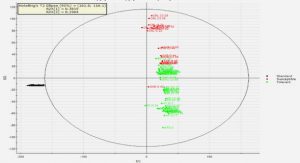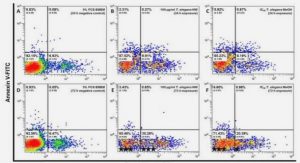Get Complete Project Material File(s) Now! »
fMRI data analysis and acquisition
fMRI testing was performed in the Centre for Advanced MRI at the University of Auckland. Blood oxygen level dependent functional images were acquired using a T2*-weighted echo planar imaging (EPI) sequence with a 1.5T Siemens Magnetom Avanto scanner using the following parameters: TR 2500 ms, TE 50 ms, FOV 192 mm, in-plane voxel size 3.0 mm× 3.0 mm, flip angle 90°, 29 slices, slice thickness 4.0 mm no gap. In each trial day 176 volumes were collected for each participant for each run and two runs were completed at each visit with a 30 second break between each run. For anatomical reference, a highresolution structural MPRAGE image was acquired for each participant at the end of the first session. A gambling (guessing) task was completed during image acquisition by presenting images of cards (as shown in Figure 29) on a screen located 3.5 metres from the participants, at the foot of the scanner and visible via a prism built into the head restraint used to minimize head movements during the scan.
Anticipation
We recently reported that BZP reduced activation relative to placebo in the insula and the IFG in response to anticipation of monetary gains and losses (392). In the current study DEX reduced activation in the thalamus, mid cingulate and post central gyri. A direct comparison between BZP and DEX revealed only one regional difference i.e. the thalamus, where BZP had a greater effect. The DEX-induced reduction in activation of the cingulate is in line with results from Knutson and colleagues (142) who showed a reduction in DA phasic firing after giving amphetamine to healthy controls, and the regions activated are consistent with locations known to be involved in the anticipation of reward. BZP however, relative to placebo, reduced activation in regions shown to be associated with responses to stimuli that are risky or have a degree of uncertainty. Hence both DEX and BZP reduced the activation of areas sensitive to alterations in dopaminergic transmission. These regions are associated with reward based learning in the striatal-thalamo-cortical network (132, 148). However, there are distinct differences, in that BZP causes a reduction in regions sensitive to uncertainty, whereas DEX does not. This is an important finding, as it indicates that after taking BZP, the subjects were potentially more likely to have a reduction in activation in those regions that have previously be associated with risk or with uncertain outcomes. The data collected did not allow for the direct behavioural analysis of risk. Modification of the ‗gambling‘ task to incorporate an element of risk and associated reward to confirm whether these activations do indeed reflect risk is an avenue for future research.
Reward outcome
After being presented with the outcome of the gamble, i.e. win or loss, DEX showed distinct differences in comparison to placebo and to BZP. DEX increased activation in the cingulate, superior frontal gyrus post central and superior temporal gyrus relative to placebo. This implies that after the administration of DEX, there is increase in phasic firing in NAcc in response to rewarding stimuli. When BZP and DEX were compared after a rewarding outcome, DEX induced greater activation in the cingulate and the thalamus than BZP. This further adds to our knowledge about the characteristics of BZP. Although it displays similar subjective effects to amphetamine (2), there are differences in its effects in DA transmission in response to reward, possibly due to the differences in phasic firing of DA. The dose of BZP may also be the reason to the difference, previously it has been reported that the relative effects of BZP to amphetamine is 10:1, this may not be the case. Alternatively, the effects on other neurotransmitter systems such as the serotonergic and noradrenergic systems may be contributing to the differences seen.
Stroop Task and BZP, TFMPP and Combination of BZP+TFMPP in Relation to
Placebo An investigation of the acute effects of the synthetic drugs benzylpiperazine (BZP) and trifluoromethylphenylpiperazine (TFMPP) alone and in combination on impulsivity and selective attention using functional magnetic resonance imaging. Louise Curley1 , Rob Kydd2 , Michelle C Gordon1 , HeeSeung Lee1 , Reem K Jan1 , Ian J. Kirk3 , Bruce Russell1 1 School of Pharmacy, Faculty of Medical and Health Sciences, 2 Department of Psychological Medicine and 3. Department of Psychology, The University of Auckland, Private Bag 92019, Auckland, New Zealand 3.2.1. Introduction Party pills containing BZP and/or trifluoromethylphenylpiperazine TFMPP have been marketed worldwide as safe and legal alternatives to illicit recreational drugs, such as MDMA and MA, since the late 1990s. These drugs are used to enhance confidence, extend hours of socialising, induce euphoria and increase energy (4). The majority of BZP and/or TFMPP users are typically in their late teens and early twenties; however, these drugs are now illegal in the majority of countries.
Table of Contents :
- Abstract
- Acknowledgements
- List of Figures
- List of Tables
- Glossary
- Problems and Aims
- Thesis Outline
- Chapter 1: Introduction
- 1.1. BZP and TFMPP
- 1.1.1. What, Where and Who?
- 1.1.2. Benzylpiperazine (BZP): What We Know So Far
- 1.1.3. Trifluoromethylphenylpiperazine (TFMPP)
- 1.1.4. BZP and TFMPP Combined
- 1.2. Recreational Drug Use
- 1.2.1. Introduction to Recreational Drug Use
- 1.2.2. Psychostimulants: Cocaine and Amphetamines
- 1.3. Reward
- 1.3.1. Introduction to Reward
- 1.3.2. The Neuroanatomy of the Reward System
- 1.3.3. Dopamine and Reward
- 1.3.4. Serotonin and Reward
- 1.3.5. Losses and Uncertainty
- 1.3.6. Reward prediction error
- 1.3.7. Magnitude
- 1.3.8. Summary of Reward
- 1.4. Executive Function
- 1.4.1. Introduction to Executive Function
- 1.4.2. Neuroanatomy of Executive Function
- 1.4.3. Dopamine and Executive Function
- 1.4.4. Serotonin and Executive Function
- 1.4.5. Summary of Executive Function
- 1.5. Imaging
- 1.5.1. Introduction to Imaging
- 1.5.2. fMRI
- 1.5.3. Data Analysis
- 1.6. Objectives of this Research
- 1.6.1. The Concerns: Comparisons with Other Drugs
- Chapter 2: BZP, TFMPP and Reward—Is it Worth the Gamble?
- 2.1. Preamble
- 2.2. Gambling Task: Comparing BZP, TFMPP and Combination BZP+TFMPP to Placebo to Investigate the Anticipatory Stage of Reward Processing
- 2.2.1. Introduction
- 2.2.2. Materials and Methods
- 2.2.3. Results
- 2.2.4. Discussion
- 2.2.5. Conclusion
- 2.3. Gambling Task: Comparing BZP, TFMPP and Combination for the Reward Outcome Stage of Reward Processing
- 2.3.1. Introduction
- 2.3.2. Materials and Methods
- 2.3.3. Results
- 2.3.4. Discussion
- 2.3.5. Conclusion
- 2.4. Gambling Task: Comparing the Effects of BZP to Dexamphetamine to Investigate the Effects of Reward Anticipation and Reward Outcome
- 2.4.1. Introduction
- 2.4.2. Materials and Methods
- 2.4.3. Results
- 2.4.4. Discussion
- 2.4.5. Conclusion
- Chapter 3: Party Pills and the Stroop Task—Have I Got Your Attention?
- 3.1. Preamble
- 3.2. Stroop Task and BZP, TFMPP and Combination of BZP+TFMPP in Relation to
- Placebo
- 3.2.1. Introduction
- 3.2.2. Materials and Methods
- 3.2.3. Results
- 3.2.4. Discussion
- 3.2.5. Conclusion
- 3.3. Stroop Task and BZP in Comparison to Dexamphetamine
- 3.3.1. Introduction
- 3.3.2. Materials and Methods
- 3.3.3. Results
- 3.3.4. Discussion
- 3.3.5. Conclusion
- Chapter 4: Validation Task of fMRI Effects—is it Changes in Cognition or Just the Rush (of Blood)?
- 4.1. Preamble
- 4.2. Validation Task: Comparing BZP, TFMPP, the Combination BZP+TFMPP and
- DEX to Placebo to Investigate vascular effects on the BOLD signal
- 4.2.1. Introduction
- 4.2.2. Materials and Methods
- 4.2.3. Results
- 4.2.4. Discussion
- 4.2.5. Conclusion
- Chapter 5: Discussion and Conclusion
- 5.1. Preamble
- 5.2. Summary of Findings
- 5.2.1. Reward Processing
- 5.2.2. Selective Attention and Inhibition
- 5.3. Reward Processing: BZP, TFMPP and Combination BZP/TFMPP
- 5.3.1. Anticipation
- 5.3.2. Reward Outcome
- 5.4. Selective Attention and Inhibition: BZP, TFMPP and Combination and the Stroop Task
- 5.5. Comments on Toxicity of BZP, TFMPP and Combination
- 5.6. Limitations and Future Directions for Research
- 5.6.1. Limitations
- 5.6.2. Future Directions for Research
- 5.6.3. Overall Conclusion
- Appendices
- 1. Participant information form
- 2. Participant consent form
- References
GET THE COMPLETE PROJECT
Investigating the effects of an acute dose of benzylpiperazine (BZP) and trifluoromethylphenylpiperazine (TFMPP) alone and in combination on the human brain using functional Magnetic Resonance Imaging (fMRI)






